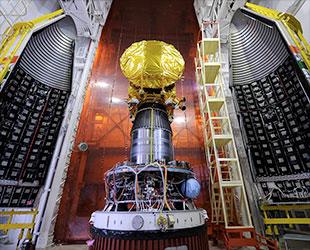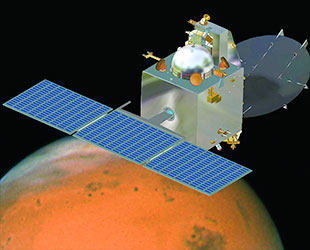November 5, 2013 — India launched its first spacecraft to Mars Tuesday (Nov. 5), on a mission that — if successful — will include the country in the exclusive club of nations capable of sending probes to the Red Planet.
The Mars Orbiter Mission lifted off at 3:08 a.m. CST (0908 GMT) on top a Polar Satellite Launch Vehicle (PSLV) from the Indian Space Research Organization's (ISRO) Satish Dhawan Space Center in Sriharikota.
The 4.5 billion rupee ($73.5 million) mission is sending the "Mangalyaan" (Hindi for "Mars-craft") spacecraft on an 10-month voyage to Mars to observe the planet's surface and atmosphere. The orbiter carries five scientific instruments, but its primary purpose is to be a technology demonstrator for future interplanetary missions, ISRO officials said.
"Orbiting Mars itself is a challenge," said the chairman of the ISRO, Dr. K Radhakrishnan, according to the Times of India newspaper. "This is our first interplanetary mission. There will be bigger missions later."

India's first interplanetary probe, the Mars Orbiter Mission (MOM) spacecraft seen being prepared for launch from Satish Dhawan Space Center SHAR in Sriharikota, India. (ISRO) |
The risks for the mission are high. It's tough to reach Mars — about two-thirds of the more than 50 missions launched to the Red Planet since 1960 have failed. India would be only the fourth country or space agency to deliver a probe to Mars after Russia, the United States and the European Space Agency — if the Mars Orbiter Mission succeeds.
It would also be the first from Asia: Japan and China have attempted to send missions to Mars, but the probes ended in failure.
India's orbiter is taking a roundabout route to reach Mars. Inserted Tuesday into a highly-elliptical orbit around Earth, the craft will spend the next month gradually increasing its distance above our planet before entering a trajectory that will take it to Mars.
If all goes as planned, the Mangalyaan orbiter will arrive at Mars on Sept. 24, 2014, ISRO officials said.
The Mars Orbiter Mission was initially scheduled to launch Oct. 28, but was pushed back when bad weather delayed the sea-going vessels that will track the spacecraft after it separates from its rocket.

Artist's illustration of India's Mars Orbiter Mission probe. (ISRO) |
As the mission's centerpiece, the Mangalyaan probe is a 2,976 pound (1,350 kilogram) spacecraft powered by solar arrays and equipped with science instruments to study the surface and atmosphere of Mars. Those five instruments include a color camera for collecting photographic images, a spectrometer for analysis of the surface's composition and mineralogy, and a methane sensor.
The methane sensor in particular is a stand-out instrument as it is designed to specifically seek out the methane gas in the Martian atmosphere. Methane has been a target of Mars scientists because, while it can be produced through geological processes, it can also be a potential indication of the presence of microbial life.
India's first Mars mission comes follows the nation's 2008 Chandrayaan 1 moon orbiter mission, which helped detect evidence of water ice on the surface. ISRO engineers are now developing a second moon probe, Chandrayaan 2, as a follow-up lunar flight.
Tariq Malik, SPACE.com's managing editor, contributed to this article.
